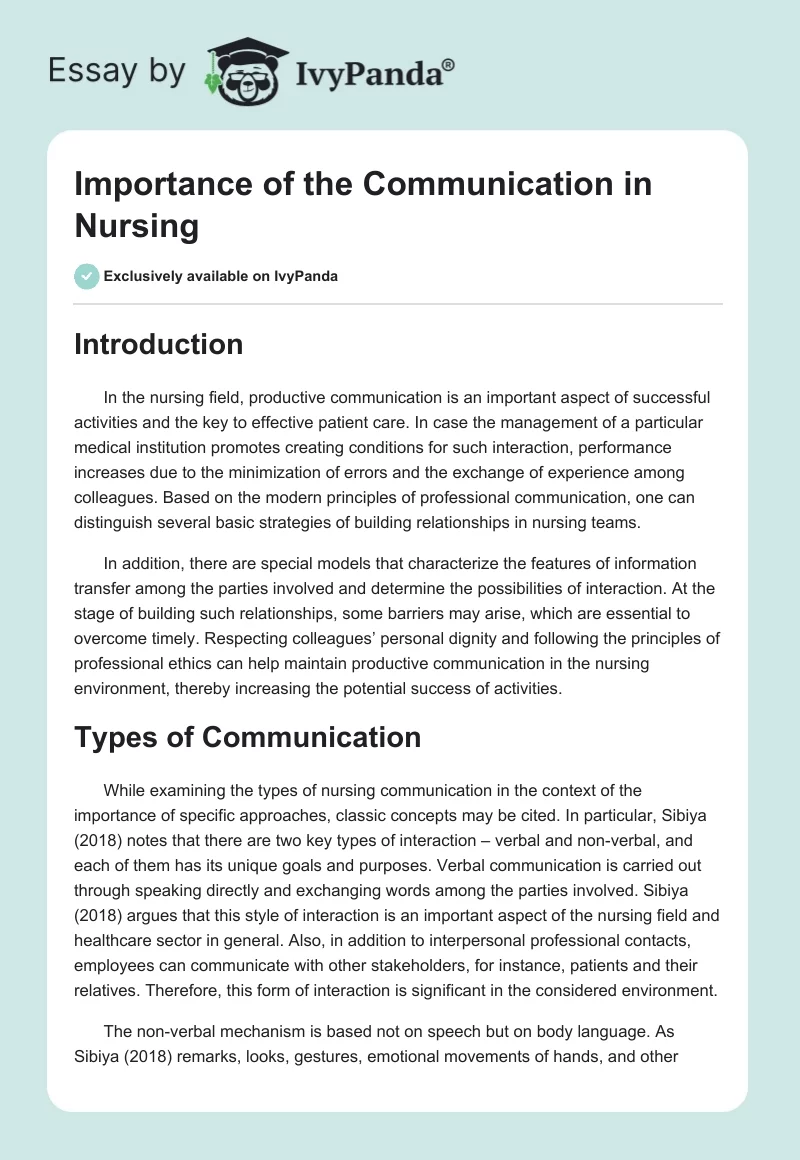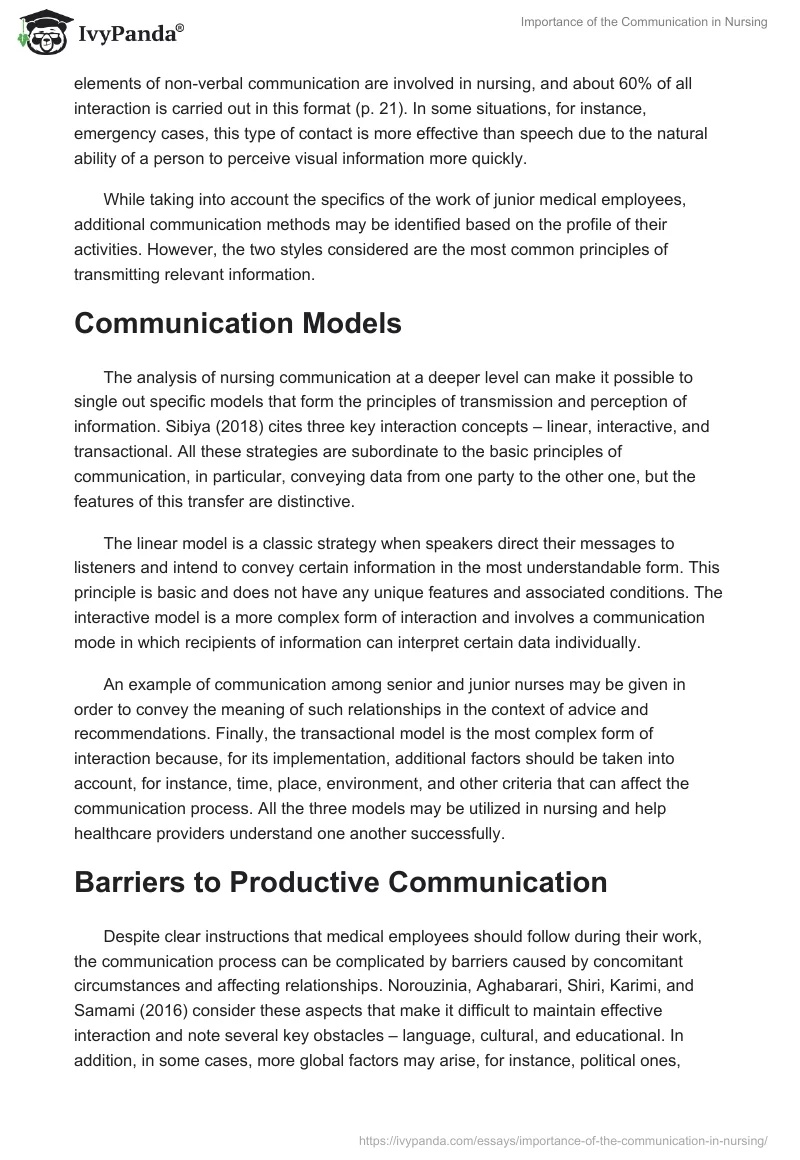Introduction
In the nursing field, productive communication is an important aspect of successful activities and the key to effective patient care. In case the management of a particular medical institution promotes creating conditions for such interaction, performance increases due to the minimization of errors and the exchange of experience among colleagues. Based on the modern principles of professional communication, one can distinguish several basic strategies of building relationships in nursing teams.
In addition, there are special models that characterize the features of information transfer among the parties involved and determine the possibilities of interaction. At the stage of building such relationships, some barriers may arise, which are essential to overcome timely. Respecting colleagues’ personal dignity and following the principles of professional ethics can help maintain productive communication in the nursing environment, thereby increasing the potential success of activities.
Types of Communication
While examining the types of nursing communication in the context of the importance of specific approaches, classic concepts may be cited. In particular, Sibiya (2018) notes that there are two key types of interaction – verbal and non-verbal, and each of them has its unique goals and purposes. Verbal communication is carried out through speaking directly and exchanging words among the parties involved. Sibiya (2018) argues that this style of interaction is an important aspect of the nursing field and healthcare sector in general. Also, in addition to interpersonal professional contacts, employees can communicate with other stakeholders, for instance, patients and their relatives. Therefore, this form of interaction is significant in the considered environment.
The non-verbal mechanism is based not on speech but on body language. As Sibiya (2018) remarks, looks, gestures, emotional movements of hands, and other elements of non-verbal communication are involved in nursing, and about 60% of all interaction is carried out in this format (p. 21). In some situations, for instance, emergency cases, this type of contact is more effective than speech due to the natural ability of a person to perceive visual information more quickly.
While taking into account the specifics of the work of junior medical employees, additional communication methods may be identified based on the profile of their activities. However, the two styles considered are the most common principles of transmitting relevant information.
Communication Models
The analysis of nursing communication at a deeper level can make it possible to single out specific models that form the principles of transmission and perception of information. Sibiya (2018) cites three key interaction concepts – linear, interactive, and transactional. All these strategies are subordinate to the basic principles of communication, in particular, conveying data from one party to the other one, but the features of this transfer are distinctive.
The linear model is a classic strategy when speakers direct their messages to listeners and intend to convey certain information in the most understandable form. This principle is basic and does not have any unique features and associated conditions. The interactive model is a more complex form of interaction and involves a communication mode in which recipients of information can interpret certain data individually.
An example of communication among senior and junior nurses may be given in order to convey the meaning of such relationships in the context of advice and recommendations. Finally, the transactional model is the most complex form of interaction because, for its implementation, additional factors should be taken into account, for instance, time, place, environment, and other criteria that can affect the communication process. All the three models may be utilized in nursing and help healthcare providers understand one another successfully.
Barriers to Productive Communication
Despite clear instructions that medical employees should follow during their work, the communication process can be complicated by barriers caused by concomitant circumstances and affecting relationships. Norouzinia, Aghabarari, Shiri, Karimi, and Samami (2016) consider these aspects that make it difficult to maintain effective interaction and note several key obstacles – language, cultural, and educational. In addition, in some cases, more global factors may arise, for instance, political ones, when legal conventions affect nurses’ work (Norouzinia et al., 2016). These obstacles may occur both in verbal and non-verbal communication forms, which complicates the work to eliminate them.
These obstacles can be interconnected and create increased discomfort for employees. For instance, language barriers are characteristic of a diverse cultural environment, and accusations based on personal bias may cause conflicts in the workplace. Also, Norouzinia et al. (2016) mention the religious context and note that in some countries, nurses cannot touch colleagues or patients of the opposite sex, which creates challenges for non-verbal communication. As a result, performance indicators are reduced due to the inability to maintain a productive work environment in which each employee can count on effective interaction and support. Therefore, searching for methods to improve communication in the nursing area is one of the priority tasks in case one or more of the aforementioned barriers are identified.
Ways to Improve Communication
In order to minimize potential barriers to productive communication in nursing, it is essential for all employees to be aware of the importance of appropriate behavioral patterns. For this purpose, MacLean, Kelly, Geddes, and Della (2017) offer to use special training materials at the early stages of education so that future employees could have an idea of the basics of ethical interaction. The manifestation of bias based on individual prejudices is unacceptable since any conflicts can lower patient outcomes, which is unacceptable. The dignity of each employee is to be respected in order to avoid interpersonal contradictions.
To enhance unique communication skills, for instance, non-verbal ones, the management of medical institutions should promote the exchange of experience among subordinates and encourage teamwork. In the context of intense activities that many nurses face, Sibiya (2018) recommends avoiding unclear messages in order to prevent misunderstandings and make the exchange of information more productive.
In addition, the ability to be convincing is a valuable quality that may allow earning authority among colleagues and become an example for them. To train this skill, it is necessary to follow all the aforementioned aspects of work and take into account ethical forms of interaction in a professional nursing environment. These measures can improve the quality of communication and, therefore, expand opportunities for successful collaboration.
Conclusion
Compliance with the principles of ethical interaction can help improve nursing communication in all its manifestations and increase patient outcomes, which is the ultimate goal of all interventions. Both verbal and non-verbal contacts are common in the medical environment in question, and appropriate models may be applied. In nursing practice, some communication barriers arise periodically due to various factors. In order to exclude them and minimize the likelihood of conflicts, rejecting bias should be a mandatory attribute of junior medical employees’ activities, and the exchange of experience may help maintain productive interaction.
References
MacLean, S., Kelly, M., Geddes, F., & Della, P. (2017). Use of simulated patients to develop communication skills in nursing education: An integrative review. Nurse Education Today, 48, 90-98.
Norouzinia, R., Aghabarari, M., Shiri, M., Karimi, M., & Samami, E. (2016). Communication barriers perceived by nurses and patients. Global Journal of Health Science, 8(6), 65-74.
Sibiya, M. N. (2018). Effective communication in nursing. In N. Ulutasdemir (Ed.), Nursing (pp. 19-36). London, UK: IntechOpen.


